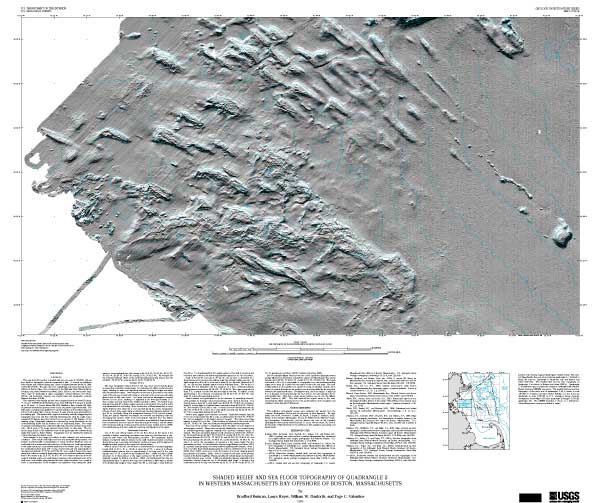
U.S. Geological Survey
Geologic Investigations Series Map I-2732-B
Version 1.0
2003
By Bradford Butman, Laura Hayes, William W. Danforth, and Page C. Valentine
|
Introduction This 40 x 35 inch map shows the sea floor in shaded relief view at a scale of 1:25,000, with sea floor depth as topographic contours overprinted in blue. It is based on multibeam echo-sounder data collected during four cruises conducted between the fall of 1994 and the fall of 1998. The map is part of a 3-quadrangle map series showing the area offshore of Boston, Mass., that is companion to the Stellwagen Bank National Marine Sanctuary map series (Valentine and others, 2001, 2003a-c; also see location map). Other maps of Quadrangle 2 depict topographic contours (Butman and others, 2003a), and backscatter intensity over shaded relief and topographic contours (Butman and others, 2003b). The multibeam echo-sounder surveys were conducted aboard the vessel Frederick G. Creed, a SWATH (Small Waterplane Area Twin Hull) ship that surveys at speeds up to 15 knots. A Simrad Subsea EM 1000 Multibeam Echo Sounder (95 kHz), mounted on the starboard pontoon of the Creed, was used to acquire these data. The bathymetric soundings were gridded at 6 m/pixel resolution and smoothed using a 9- cell by 9-cell median filter; contours having a 5-meter interval were generated from the resulting grid. The shaded relief image was created by vertically exaggerating the topography four times and then artificially illuminating the relief by a light source positioned 45 degrees above the horizon from an azimuth of 350 degrees. In the resulting image, topographic features are enhanced by strong illumination on the northward-facing slopes and by shadows cast on south-facing slopes. The image accentuates small features that could not be effectively shown by contours alone at this scale. Blank areas in the image represent places where no data exists. The two narrow strips of data in the southwest corner of the quadrangle were collected along single ship transits to Boston Harbor. Topographic lows are identified by hachured contours (hachures face deeper water). Some features in the image are artifacts of data collection and environmental conditions. They include small highs and lows and unnatural-looking features, and patterns oriented parallel or perpendicular to survey tracklines (tracklines were run north-south in the eastern and north-central part of the map area, northwest-southeast in the south-central part, and northeast-southwest in the western part). For example, the wrinkle-like features about 100 m long, oriented east-west and perpendicular to the ship's track between 70°39' W. and 70°42' W., are a result of heave of the vessel during data collection caused by large surface waves; the northeast-southwest-trending lines in the vicinity of 42°21.5' N., 70°47.5' W. are a result of data loss in the far range of individual swaths; and small offsets in features in the southwestern part of the study area, most notable along features that have sharp transitions, are a result of errors in synchronization of the navigation and multibeam clocks during the 1994 survey (a diamond-shaped area with corners at 42°19.5' N., 70°48' W.; 42°23' N., 70°43.5' W.; 42°26' N., 70°48' W.; and 42°23' N., 70°52.5' W.). For example, see the northeast-southwest offsets of the northwest-southeast-trending features near 42°21.94' N., 70°47.88' W., and near 42°23.74' N., 70°48.59' W". |
 |
| Thumbnail image of map I-2732-B |
Geologic Investigations Series Map I-2732-B [1-MB PDF file]
Download free Adobe Reader software.
Visit the Adobe accessibility website.
Contact Information
For questions about the scientific content of this report, contact Bradford Butman.
[an error occurred while processing this directive]